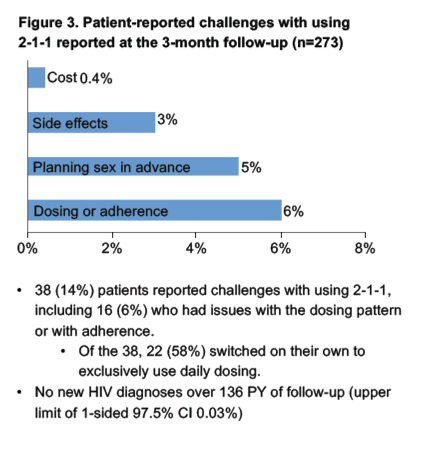 |
 |
 |
| |
Implementation of On-Demand PrEP in a Large Integrated Healthcare System
|
| |
| |
CROI 2020
J. Carlo Hojilla1,2, Julia L. Marcus3, Rachel Herbers4 C. Bradley Hare4, Leo Hurley1, Michael J. Silverberg1, Derek D. Satre1,2, Jonathan E. Volk4
1Kaiser Permanente Division of Research, Oakland, CA, USA, 2University of California, San Francisco, CA, USA, 3Harvard Pilgrim Health Care Institute, Boston, MA, USA, 4Kaiser Permanente San Francisco Medical Center,
San Francisco, CA, USA

abstract
Data describing real-world implementation of on-demand (2-1-1) HIV preexposure prophylaxis (PrEP) are limited. In this study, we report on the experiences of early 2-1-1 adopters in Kaiser Permanente San Francisco (KPSF).
KPSF started offering 2-1-1 PrEP in February, 2019. We abstracted data from the electronic health record, including demographics, reasons for selecting 2-1-1, and self-reported challenges, adherence, and persistence. These were collected by clinicians at baseline and at follow-up visits using standardized notes. We examined data descriptively and, for those with 3-month follow-up data, we used Fisher’s exact tests to compare demographics between those who did and did not continue using 2-1-1 PrEP.
As of August 2019, there were 2338 active PrEP patients in KPSF, with 251 (11%) using 2-1-1 PrEP. At baseline, median age of individuals using 2-1-1 was 43 (range 18-78); most were white (57%), MSM (99%), and had previously used daily PrEP (76%). In total, 179 patients (71%) had 3-month follow-up data available at the time of analysis. Of these, 23 patients (13%) reported challenges with using 2-1-1 PrEP, including difficulty planning sex in advance, adherence to the dosing schedule, and side effects. Ninety patients (50%) used 2-1-1 PrEP as their sole dosing regimen in the last 3 months; 35 (20%) opted to stay on daily PrEP despite their initial interest in 2-1-1 dosing; 34 (19%) used a combination of 2-1-1 and daily dosing; 4 (2%) used a different intermittent dosing regimen; and 16 (9%) had discontinued PrEP, primarily because of loss of insurance or change in sexual risk. We found no differences in use of 2-1-1 PrEP at the 3-month follow-up by age or race/ethnicity (P>0.05). Of the 90 who reported using only 2-1-1 PrEP at the 3-month follow-up, the majority (90%) cited infrequent sex as their reason for opting against a daily regimen. Only 3 (3%) individuals using 2-1-1 PrEP reported missed doses at their last sexual encounter, and none had started postexposure prophylaxis.
Our findings suggest that 2-1-1 PrEP is a desirable alternative for many patients. While missed 2-1-1 doses were infrequent in our setting, many individuals changed back to a daily dosing strategy or transitioned between daily and 2-1-1 dosing. With potential scale-up of 2-1-1 PrEP in the U.S., resources to support patients as they transition between dosing regimens are needed, as well as interventions to support the optimal use of 2-1-1 PrEP.


|
| |
|
 |
 |
|
|